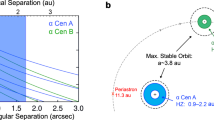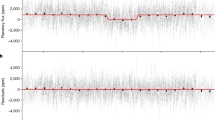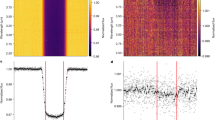Abstract
Triton, the major satellite of Neptune, and Pluto, the outermost planet, are too small and distant to permit direct measurement of their size, and indirect arguments must be used to estimate diameter and albedo. These two objects invite a comparative study because they have essentially the same brightness (absolute visual magnitude V(1, 0)≃ −1) and current distance from the Sun (30 AU). In addition, the presence of methane frost on the surface, and of a possible methane atmosphere, have been detected for both objects from IR spectroscopy1–4. On the basis of these similarities, Triton and Pluto were selected as targets for possible detection of thermal IR emission. We report here new upper limits to the thermal IR emission from these objects that permit us to set significant upper limits on their diameters and to demonstrate that both are high albedo objects. These results clearly exclude the possibility that Triton is the largest planetary satellite, and they are consistent with the small size of Pluto deduced from other data.
This is a preview of subscription content, access via your institution
Access options
Subscribe to this journal
Receive 51 print issues and online access
$199.00 per year
only $3.90 per issue
Buy this article
- Purchase on Springer Link
- Instant access to full article PDF
Prices may be subject to local taxes which are calculated during checkout
Similar content being viewed by others
References
Cruikshank, D. P., Jones, T. J. & Pilcher, C. B. Science 194, 835–837 (1976).
Cruikshank, D. P. & Silvaggio, P. M. Astrophys. J. 233, 1016–1020 (1979).
Soifer, B. T., Neugebauer, G. & Matthews, K. Astr. J. 85, 166–167 (1980).
Fink, U. et al. Icarus 44, 62–71 (1980).
Simon, T., Morrison, D. & Cruikshank, D. P. Astrophys. J. Lett. 177, L17–L20 (1972).
Morrison, D. & Simon, T. Astrophys. J. 186, 193–206 (1973).
Brown, R. H., Cruikshank, D. P. & Morrison, D. Nature 300, 423–425 (1982).
Morrison, D. Icarus 19, 1–14 (1973).
Jones, T. J. & Morrison, D. Astr. J. 79, 892–895 (1974).
Tedesco, E. F. & Tholen, D. J. Bull. Am. astr. Soc. 12, 729 (1980).
Degewij, J., Andersson, L. E. & Zellner, B. Icarus 44, 520–540 (1980).
Brown, R. H., Morrison, D., Telesco, C. M. & Brunk, W. E. Icarus (in the press).
Smith, B. A. et al. Science 212, 163–191 (1981).
Kuiper, G. P. Trans. IAU 9, 250–251 (1957).
Cruikshank, D. P., Stockton, A., Dyck, H. M., Becklin, E. E. & Macy, W. Jr Icarus 40, 104–114 (1979).
Morrison, D. & Cruikshank, D. P. Space Sci. Rev. 15, 641–739 (1974).
Morrison, D., Cruikshank, D. P. & Burns, J. A. in Planetary Satellites (ed. Burns, J.) 3–17 (University of Arizona Press, 1977).
Smith, B. A. et al. Science 215, 504–537 (1982).
Harrington, R. S. & Christy, J. W. Astr. J. 88, 442–443 (1981).
Arnold, S. J., Boksenberg, A. & Sargent, W. L. W. Astrophys. J. Lett. 234, L159–L163 (1979).
Bonneau, D. & Foy, R. Astr. Astrophys. 92, L1–L4 (1980).
Author information
Authors and Affiliations
Rights and permissions
About this article
Cite this article
Morrison, D., Cruikshank, D. & Brown, R. Diameters of Triton and Pluto. Nature 300, 425–427 (1982). https://doi.org/10.1038/300425a0
Received:
Accepted:
Issue Date:
DOI: https://doi.org/10.1038/300425a0
This article is cited by
-
The Pluto Energetic Particle Spectrometer Science Investigation (PEPSSI) on the New Horizons Mission
Space Science Reviews (2008)
-
On the origin of Triton
Earth, Moon, and Planets (1986)
-
On the origin of Triton and Pluto
Nature (1984)
-
Diameters and albedos of satellites of Uranus
Nature (1982)
Comments
By submitting a comment you agree to abide by our Terms and Community Guidelines. If you find something abusive or that does not comply with our terms or guidelines please flag it as inappropriate.



